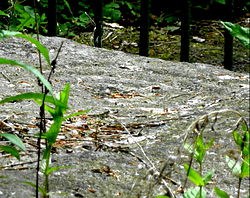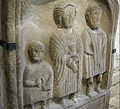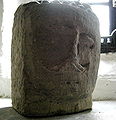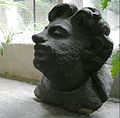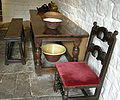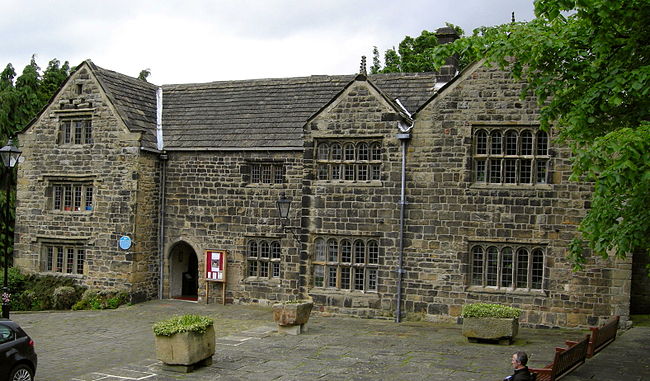- Manor House Museum
-
Manor House Art Gallery and Museum 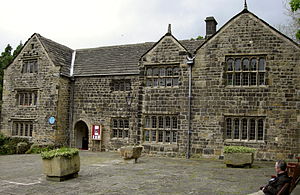
The front or south elevation of the Manor House Museum, IlkleyEstablished 1892 Location Castle Yard, Ilkley, West Yorkshire, England LS29 9DT Type Heritage centre, Historic house museum, Interpretation centre Public transit access Ilkley railway station; Ben Rhydding railway station Website www.bradfordmuseums.org Manor House Museum, Ilkley, England, is a local heritage museum, art gallery and education centre, established in 1892 to preserve local archaeological artefacts after the spa town expanded and much Roman material was lost. It was re-opened in the present building in 1961. Admission to the Museum is free of charge.
Contents
History of the museum
The following are key events in the history of the museum:[1]
- 1892: The museum was established in 1982 by the Museum Committee (president: Dr G. Carter) under the auspices of the Ilkley Ratepayers' Association. This had become urgent when the expansion of the spa town of Ilkley caused disturbance of Roman and other remains under the town. It was said that Roman material was being carried away by the cartload, and local antiquarians had been attempting to rescue and preserve some of these artefacts - but they had nowhere to display them. The present manor house building, known as the "Old Castle" was the committee's first choice, but was too expensive, so they bought the Old Wesleyan Chapel (b.1834). The opening ceremony was on Thursday 25 August 1892. The Rev. Dr Collyer, who gave the opening speech, asked his audience to guard both the rescued artefacts and the archaeological remains that were still buried under Ilkley. The first curator was Herbert Oxley, who was paid £1 per week. On 14 September it was renamed the Ilkley Museum and Antiquarian Society.
- 1896: Ilkley Urban District Council took over the museum. Oxley the curator died, to be replaced by his wife.
- 1908: The museum was moved to the upper floor of the new Public Library, which had been opened in 1907. William Graham took over as curator; he held the post until 1942.
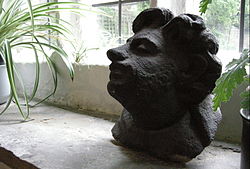 sandstone carved head.
sandstone carved head.
- 1922: Donations had expanded the collection, but the museum could not afford to move to larger premises. An unmanageably large collection of non-local objects interfered with classification and display of its local core items: the Roman artefacts. Therefore the collection had to be reduced. Many non-local items were returned to owners or loaned to Cliffe Castle Museum, Keighley.
- 1939–1948: The museum exhibits were packed away to make room for wartime administration. The curator William Graham died and was not replaced. Items in storage became muddled together or went missing.
- 1949: The museum was re-established, with Grace Simpson restoring order, and Elsie Fletcher becoming Honorary Curator. It was reopened on 4 June 1949 as Ilkley Museum.
- 1954: Elsie Fletcher started the Olicana Museum Society, which later became the Olicana Historical Society. This society is in effect an extension of the original protective measures of the museum, in that it takes a keen interest in local archaeological and historical heritage, and organizes lectures and excursions.
- 1955–1961: The Old Castle — Manor House Museum's current building - became available to the Museum but was in a sorry state and required cash and conversion. Costs were quoted at £7,000-£10,000, but there were contributions from Ilkley Urban District Council and Percy Dalton, and a grant from the Ministry of Works. The present Manor House Museum and Art Gallery was opened on 8 July 1961.
- 1962–present: From 1963 both upper rooms have been art galleries. The caretakers lived upstairs at first, but in 1974 their rooms became offices. From 1966 to 1977 Arthur Kitching was curator and organiser of exhibitions. The restored Old Castle building itself became the main exhibit of the Museum, and from 1963 it has been supported by the Friends of the Manor House society. Since the Arts and Museums Division of the Bradford Metropolitan District was formed in 1974, the Manor House Museum has been able to get some of its lost exhibits back, and has benefited from communal museum resources.
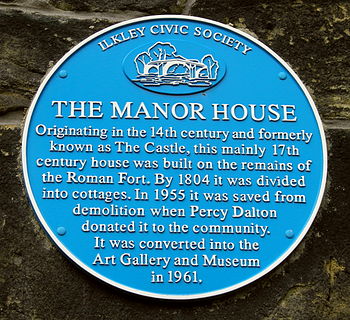 The Museum's blue plaque
The Museum's blue plaque
Early exhibits
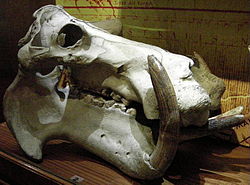 Hippopotamus amphibius skull at Cliffe Castle Museum, Keighley: possibly the one given by Ilkley Museum in 1928.[2]
Hippopotamus amphibius skull at Cliffe Castle Museum, Keighley: possibly the one given by Ilkley Museum in 1928.[2]
The following are some key early exhibits at the museum:
- 1893: The earliest exhibits were local geological and botanical specimens, drawings of local stones with Neolithic or early Bronze Age cup and ring engravings, local Roman relics including a triple vase, and relics of the local character James Fletcher the fiddler, known as Blind Jim. The Museum had his portrait and 18th century chair.[3]
- 1925: On 21 August, the Ilkley Gazette received a letter of complaint that the collection was just a curiosity shop, and this led to the reduction of the collection in favour of its local heritage items. However the letter did include a description of the exhibits of the time. There was the Ellison collection of classified geological specimens. There were photographs of the local great and good, a stuffed albatross and Japanese armour. There were valuable coins, a Queen Victoria mug, and the Anglo-Saxon cross shaft carvings, unlabelled. The "famous Roman triple vase [. . .] found near the Assembly Hall in Weston Road"[4] was still there with a serpent, boomerangs and a sawfish. The existence of superfluous paintings was bemoaned, with special attention being paid to the portraits of the Rombalds Moor hermit, and of James Fletcher (his name now changed to Metcalfe) the local 18th century blind fiddler - this latter was in the Museum's foundation collection, and possibly held some sentimental value for Ilkley residents. It might also be worth noting that Mr Woodward, the classifier of the Roman artefacts, was absent in Greece when this article was written - so there may have been some political element involved in the publication of this piece. The primary complaint is that items were intermixed and were not all labelled or classified, and the secondary complaint is that there was insufficient space to separate and classify them all properly. It appears well-intentioned, but there are possibly intimations of an administrative power-struggle in the background.[1]
- 1928: Some exhibits were returned to their owners, and Keighley Museum was given some of the non-local items, e.g., the hippo skull; mounted birds and animals including kiwis, platypus, horned heads and otter head; Japanese armour; lion skull; various ethnographic items. However Keighley was also given the cherished local Ellison collection of classified geological specimens, perhaps because the Ilkley site above the library could not display it as it deserved.[1]
- Current whereabouts of the lost early exhibits: The Ellison collection is still at Keighley, in Cliffe Castle Museum (the successor to Keighley Museum), but is unidentifiable as such to the visitor, as it has been mixed with other collections for display purposes, and very few of the collections are labelled as such. The hippo skull is believed to be still extant (see picture, left) and there is a lion skull on display. However the other items are currently untraceable. Neither the Manor House Museum nor Cliffe Castle Museum appears to know the whereabouts of the painting of Blind Jim the fiddler, or of his 18th century armchair.[5]
- 1939: From the start of World War II for nine years the remaining core collection was in storage, where it deteriorated, and some items were lost.[1]
Current exhibits
Currently, the collection is exhibited in rotation. Sadly the famous Roman triple vase is not always on display for that reason,[6] although it attracts visitors because it is the one item which has been consistently listed in reports of the collection since 1892.[1]
-
Neolithic arrowheads
-
Gritstone bas-relief of Romano-British woman.
-
Gritstone bas-relief of Romano-British woman.
-
Sandstone bas-relief of Roman family.
-
Samian ware sherds.
-
Carved oak 18th century Bible box.
-
Oak bench from home of Thomas Chippendale, possibly made by him or his father.
-
Oak bench from home of Thomas Chippendale, possibly made by him or his father: closeup.
-
Yorkshire chair, 19th century.
The Manor House (Old Castle) building
The Manor House building is of historic interest.[7] The building stands on a Roman fort. This is the oldest dwelling-house in Ilkley and was built along with the parish church on the fort Olicana. The church was built in Anglo-Saxon times on top of the Principia or headquarters building of the fort. The Manor House was built into the west defences: that is, it was incorporated with part of the free-standing defensive west wall of the fort, and many robbed-out Roman small squared stone blocks are now part of the building.
The front or south elevation. The building faces south. The left or west wing, where the Museum shop is situated, is partly medieval and was built on the Roman fort wall. The interior entrance to the shop has a 14th century shouldered lintel. The mullioned windows are 17th century. The central gable covers the main eating hall with fireplace, and the right or east gable is the solar wing, containing upstairs accommodation for the owner, with a garderobe and fireplace. The front walls and windows of the central hall and solar wing are 16th century. The front doorway with pointed arch is possibly late Norman, 14th century.
The back or north elevation of the building is partly built with stones robbed out from the Roman fort. The passage doorway may be medieval, but the archway and right (west) wing are 17th century. The wall beneath the central and east gables on this side is 15th to 16th century. The lowest large window in the solar wing on this north side is 17th century; other north-elevation windows are more modern.
In the interior roof of the solar room, the rigid 15th or 16th century structure of king posts, tie beams and principal rafters forms the main frame of the roof, as a series of triangular trusses.
Educational facility
For some of the time, the ground floor room in the solar wing is used for educational purposes, especially when local schoolchildren are studying Roman history.[6]
References
- ^ a b c d e Gavin Edwards and Denise Shillitoe, Ilkley and its Museum 1892–1992, 1992. (Available at the Museum.)
- ^ Opinion given by current Keighley museum staff, though they cannot be sure.
- ^ Antiquary, 1893.
- ^ Ilkley Museum: Bigger Home Needed, Ilkley Gazette, Friday 21 August 1925.
- ^ Information from staff of Cliffe Castle Museum, Keighley, and of the Manor House Museum.
- ^ a b Information from Museum staff.
- ^ West Yorkshire Archaeological Service, Historic Houses of West Yorkshire: The Manor House Ilkley (leaflet), 1987 & 1982. (Available free at the Museum.)
External links
Coordinates: 53°55′38″N 1°49′29″W / 53.92722°N 1.82472°W
City of Bradford Towns,
villages,
areas,
suburbs
and wardsAddingham · Allerton · Apperley Bridge · Baildon · Barkerend · Belle Vue · Ben Rhydding · Bingley · Bingley Rural · Bingley ward · Bolton and Undercliffe · Bowling and Barkerend · Bradford · Bradford Moor · Broadway · Burley in Wharfedale · Burley Woodhead · Buttershaw · City of Bradford · City ward · Clayton · Cottingley · Craven ward · Crossflatts · Cross Roads · Cullingworth · Cutler Heights · Denholme · Dudley Hill · East and West Morton · East Bowling · Eastburn · Eccleshill · Eldwick · Esholt · Forster Square · Gilstead · Great Horton · Greengates · Harden · Haworth · Haworth, Cross Roads and Stanbury · Heaton · Holme Wood · Idle · Idle and Thackley · Ilkley · Ingrow · Keighley · Keighley Central · Keighley East · Keighley West · Laisterdyke · Little Germany · Little Horton · Long Lee · Low Moor · Lumbfoot · Manningham · Menston · Oakenshaw · Oakworth · Odsal · Oldfield · Oxenhope · Queensbury · Ravenscliffe · Riddlesden · Royds · Saltaire · Sandy Lane · Shipley · Silsden · Stanbury · Steeton · Steeton with Eastburn · Thackley · Thornbury · Thornton · Thornton and Allerton · Toller · Tong · Trident · Tyersal · Westfield · Wharfedale ward · Wibsey · Wilsden · Windhill and Wrose · Worth Valley · Wrose · WykeGovernance Culture
and
TourismCountrysideBuildingsBradford Cathedral · Bradford City Hall · East Riddlesden Hall · Lister Mills · Mechanics' Institute Library · Midland Hotel · Oakworth Hall · Ponden Hall · Salts Mill · The Gatehaus · Wool ExchangeTheatres,
halls & cinemasBradford Alhambra · Cubby Broccoli Cinema · Ilkley Playhouse · IMAX · Keighley Picture House · Odeon Leeds-Bradford · Pictureville Cinema · St George's Hall · The PriestleyMuseumsBolling Hall · Bracken Hall Countryside Centre and Museum · Bradford Industrial Museum · Bronte Parsonage Museum · Cartwright Hall · Cliffe Castle Museum · Ilkley Toy Museum · Manor House Museum · Museum of Rail Travel · National Media Museum · Peace Museum · TransperienceShoppingParksEventsBingley Music Live · Bradford MelaHeritageHospitals Education Media PublishingRadioTVCompanies British Wool Marketing Board · Club 18-30 · Ellis Briggs · Findel plc · Grattan · Greenwoods · JCT600 · Kelda · Wm Morrison Supermarkets · Mumtaz Group · Pace Micro Technology · Provident Financial · Safestyle UK · Seabrook Potato Crisps · Sports Turf Research Institute · Stylo · Yorkshire Building Society · Yorkshire WaterSport TeamsVenuesWaterways RiversCanalsCrossingsBeckfoot Bridge · Ireland Bridge · Thornton viaductTransport AirRailBusBus stations: Bradford Interchange · Ilkley bus station · Keighley bus station
Services: Arriva Yorkshire · First Bradford · First Calderdale & Huddersfield · First Leeds · Keighley & DistrictRoadMiscellaneous Categories:- Museums established in 1892
- Museums in Bradford
- Art museums and galleries in West Yorkshire
- Country houses in West Yorkshire
- Archaeology museums in England
- History of West Yorkshire
- Museums in West Yorkshire
- Local museums in West Yorkshire
- 1892 establishments in England
- Ilkley
Wikimedia Foundation. 2010.

